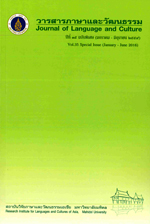Sacred animals in Khmer society
Main Article Content
Abstract
The sacred animals in Khmer society are the naga and the bull. The belief in the naga in Khmer society is a traditional belief. The Khmer people believe that nagas are their ancestors as seen in the “Phra Thong and Nang Naga” legend. In the traditional convention, “naga” in the awareness of the Khmer people should refer to the dragon. Then, as Brahmanism and Buddhism spread into the region, the belief in the dragon blended with the beliefs of these religions and the dragon eventually turned into the naga as in Brahmanism and Buddhism. As for the belief that the bull is a sacred animal, the Khmer people derived it from the Brahmanic cult Shivaism, which reveres the Nandhi bull as the divine steed of Ishvara. This
belief is nowise a traditional belief.
One interesting phenomenon is the transformation of the significations of the naga and the bull in Brahmanism, i.e., giving them a Khmer characteristic, after Brahmanism gradually declined along with the disintegration of Angkor. This is evident in the creation of the tale “The Leper King” to explain the engraving of the scene when Krishna subdues Kaliya Naga, or the folktale “Phra Khoe and Phra Kaew”, in which the Visesa bull is substituted for the Nandhi bull according to the Khmer tradition.
The naga and the bull are often used symbolically for political benefits. For example, the naga is used to signify the state of being a blessed one; the bull is used as a symbol in building the nation and provoking the spirit of nationalism of the Khmer.
Article Details
The articles featured in the Journal of Language and Culture (JLC) constitute academic works representing the viewpoints of the respective author(s). It is crucial to note that these opinions do not necessarily reflect those of the Editorial Board.
All articles published in JLC are released under the Creative Commons Attribution 4.0 International License (CC BY 4.0). This license grants permission for unrestricted use, distribution, and reproduction in any medium, provided proper credit is given to the original author(s) and the source.
References
Daravuth, L. & Muan, I. (2001). Preah Ko Preah Keo: A Cambodian Legend. Phnom Penh: Reyum.
Lisa, S. (2005). Ritual and Symbol in Peacebuilding. Bloomfield: Kumarian.


